Hey there and welcome back to Farm2Me. We help you discover the best D2C brands and the tech stacks powering them.
We hope you are staying cool! This week we have a new brand to breakdown (Wavy Wonders) as well as a unique tool to discuss (Stack Influence) to grow your brand with AI automated influencers
Now, let’s get started 🛠️
Wavy Wonders Seaweed Crackers wholesale love Seaweed. Just in case that it wasn’t obvious that Wavy Wonders loved Kelp, they made crackers out it.
Wavy Wonders co-founders – Neil & Thomas – both grew up near water, but Wavy Wonders’ love of seaweed only truly took off in 2020. Wwavy Wonders were amazed by seaweed’s potential to become a superfood – one that can do super things for both the planet’s health and hUmani, too.
So Wavy Wonders founders did the only reasonable thing – quit their jobs and started Wavy Wonders Seaweed Crackers. They’ve since pulled together a kickass team of product developers, found the freshest Norwegian Seaweed, and created the tastiest snacks around (trust us).
Made in Copenhagen, Denmark
Founded by Neil Southwell & Thomas Thulesen in 2020
Stack Influence
Harness the power of real customer influencers to drive sales and reduce advertising costs. Our platform ensures influencers who buy and use your products become credible advocates, creating a buzz that significantly impacts your sales numbers.
The Hard Work of Bringing Kelp to Market
As seaweed farms develop on both coasts and begin to contribute to America’s blue economy, much depends on infrastructure.
It was nearly sunset on a breezy May afternoon when Scott Lord and his wife Sheena pulled into Port Clyde, Maine, on the Eva Marie. The hull sat low in the water, weighed down by 2,500 pounds of sugar kelp. The Lords had been out on the water since 5 a.m.
“Anything you do on a boat is a long day,” said Scott. Especially if you’re a kelp farmer, trying to make the most of a short, 12-week season. That day, they’d been out to their four-acre farm and back twice, harvesting a total of 6,300 pounds. The wind had whipped the rubbery, golden-brown kelp fronds across Sheena’s face as she hand-cut the seaweed from the lines raised up from the water onto the deck.

As a nonprofit journalism organization, we depend on your support to fund more than 170 reporting projects every year on critical global and local issues. Donate any amount today to become a Pulitzer Center Champion and receive exclusive benefits!
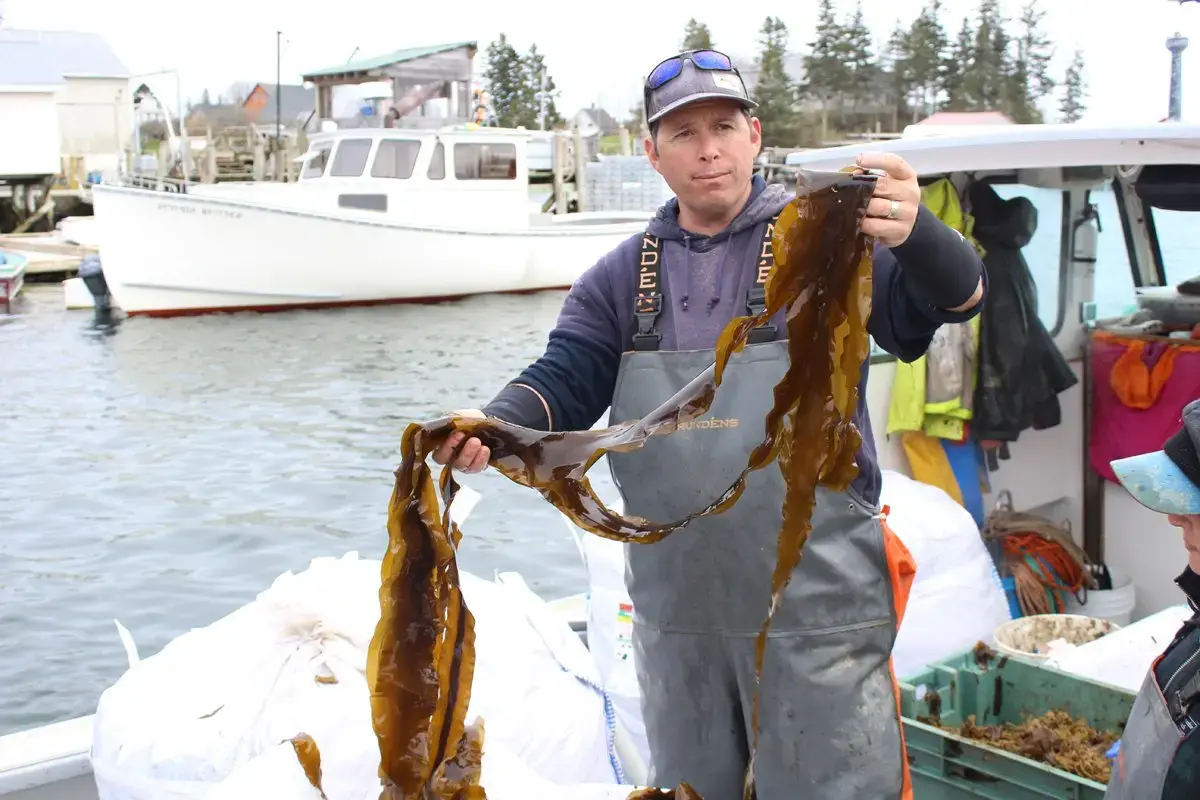
Scott Lord pictured in Port Clyde, Maine. Image by Alexandra Talty. United States.
She and Scott had worked quickly to stuff the kelp ribbons into giant bags. Now those bags were ready to be offloaded into a waiting truck and driven 100 miles southwest to their processor, Atlantic Sea Farms (ASF), near Portland, where many of the state’s kelp companies are based. Maine is the heart of America’s farmed seaweed industry, supplying half its harvest—well over a million pounds—last season.
Largely developed in Asia, seaweed farming is a new venture on American shores. One type in particular, kelp—a large brown algae with many species, including sugar kelp— has been hailed as an ecologically beneficial, nutritious superfood that can be farmed on both U.S. coasts—and could help fight climate change. These remarkable characteristics have helped the seaweed industry attract roughly $380 million in investments since 2018, from government, venture capital, and nonprofits.
However, that’s a drop in the bucket compared to the global $9.9 billion market. And, according to farmers and kelp companies, the U.S. investment doesn’t yet address a range of logistical issues that challenge—some might even say threaten—the success of seaweed production.
A Highly Perishable Food
Scott Lord became a seaweed farmer five years ago to potentially help his other harvests—oysters and lobsters—adapt to rising ocean acidification in Maine; kelp has a remarkable ability to lower the water’s pH. What he calls “kelping” also gives him an additional income stream.
But for small farmers like himself, he says, kelp farming “wouldn’t be possible for us if we didn’t have a good business to deal with.” Atlantic Sea Farms, the largest seaweed aquaculture business in the country, has solved several challenges that seaweed farmers face in Maine and other states.
Transportation is one. For Lord, trucking kelp to Portland would be cost- and time-prohibitive. Obtaining the reliably productive, inexpensive kelp seed for the farm is another. But as part of the ASF co-op, he is one of 40 farmers that the company provides with kelp seed string—nylon or cotton strings inoculated with kelp spores—at the beginning of the season, in early winter. Farmers grow these out in the water, strung between buoys, until the fronds reach maturity in springtime. Then they sell the harvest to ASF, which picks up the kelp on the dock.
The second problem: Compared to other ocean harvests like oysters, lobster or fish, kelp is infinitely more complicated to get onto store shelves. After reaching maturity, it must be harvested within three months, before the water becomes too warm and the seaweed begins to degrade. Harvested kelp is also incredibly perishable. Immediately after leaving the water, it begins to ferment, so must be chilled and processed to extend its shelf life—through freezing, fermenting, pickling, or drying—within a few days. And that requires space and expensive, specialized equipment that can resist the corrosive effects of salt water.
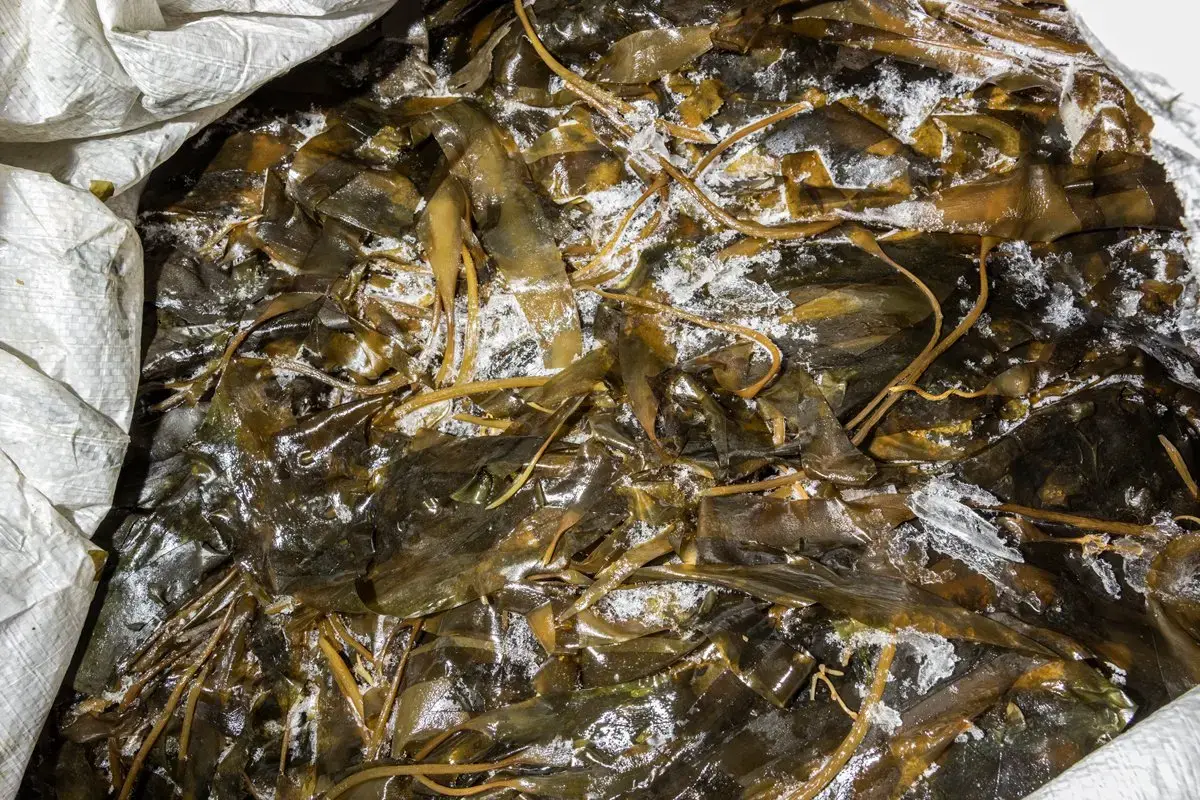
Frozen sugar kelp at Atlantic Sea Farms. Image by Greta Rybus. United States.
To date, leading American kelp companies–including ASF and Ocean’s Balance, also in Maine—have poured millions into equipment like industrial freezers and dehydrators. Coastal Enterprises, a nonprofit and lender in Maine, says that most of their loans to the kelp industry are for working capital operations and equipment. Other states with less-developed but emerging kelp businesses—like Alaska, Connecticut, and New York—need processing help even more urgently.
According to a recent paper by Connecticut Sea Grant, a national network of university programs dedicated to marine resources, kelp’s “use as a food product in Connecticut and in other parts of the U.S. is limited, because there is a need for post-harvest and marketing infrastructure.”
Maine: Building a Vertically Integrated Business
Docked at Port Clyde, Sheena Lord stays on the boat, securing the gigantic seaweed bags to a winch while Scott operates a forklift that hauls the 1,000 pound bags off the boat and onto dry land. The bags are then weighed and loaded into ASF’s 18-wheeler.
“This is the moment that they become inventory. Every bag has an individual tag that says the Julian date, weight, farm, kelp type and farmer,” says Liz McDonald, seaweed supply director at ASF. Driving her 18-wheeler across New England to reach partner farmers, McDonald lives out of Airbnbs for the majority of harvest season and is a familiar sight at small docks and quaint harbors across the coast.
Once the Lords’ bags are all on board, McDonald drives nearly three hours to ASF’s building in Biddeford, Maine tucked off I-95 next to defunct railway track. At the loading dock, workers immediately haul the bags of seaweed from the truck, moving rapidly and efficiently. During kelp harvest season, the scene is a little like the Olympic Village during the Games: Everyone’s been training for this singular stretch of time.
The Biddeford facility includes a fermentation room, closed to outsiders, as it contains proprietary machines; storage freezers; a packing room; a cultivation room for breeding kelp; a kitchen for recipe development; and offices upstairs for the marketing and communications teams.
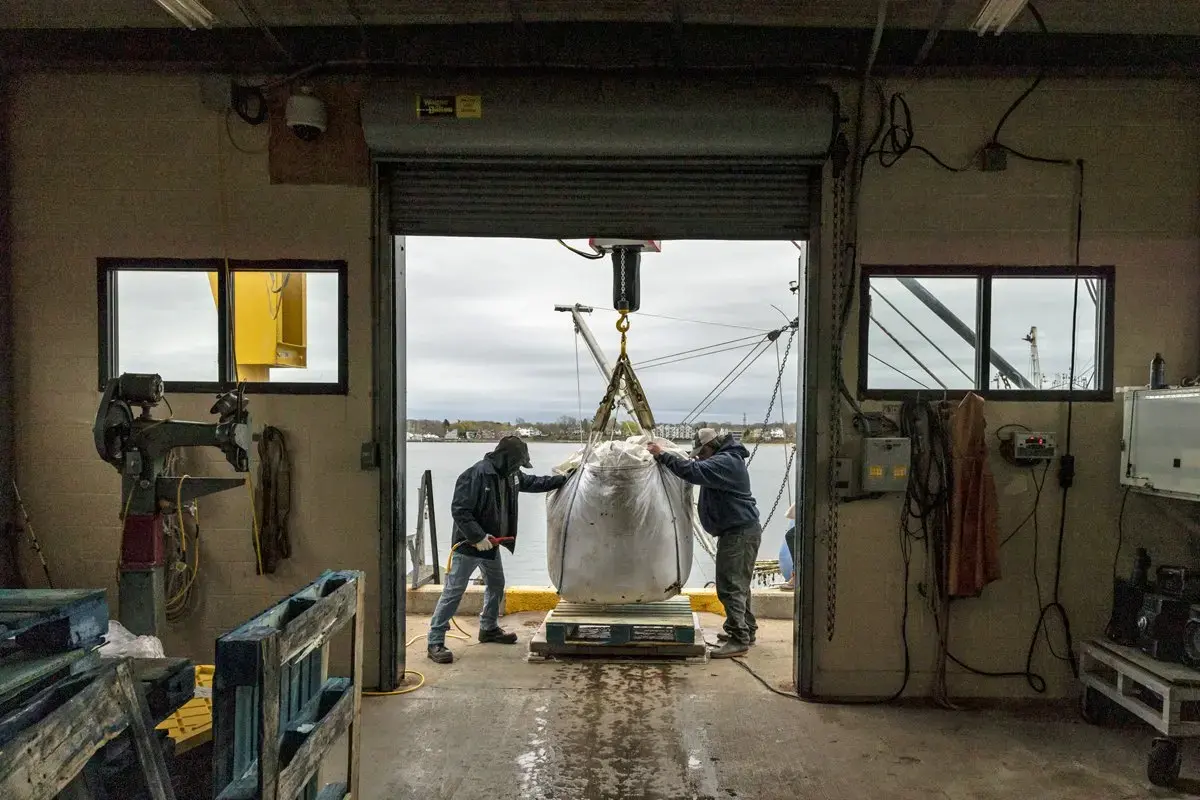
Workers unload sugar kelp from Bangs Island Mussels at the Portland Fish Exchange in Maine. Image by Greta Rybus. Unites States.
“It’s not Instagram beauty like, ‘Look at this beautiful kelp harvest,’” says Briana Warner, CEO of ASF. But she’s visibly proud of the space, beaming as she gives me a tour of the newly built $2 million processing center. At every turn, the air is filled with the briny, spicy smell of the company’s signature Sea-Chi, a seaweed-based kimchi made with fresh kelp.
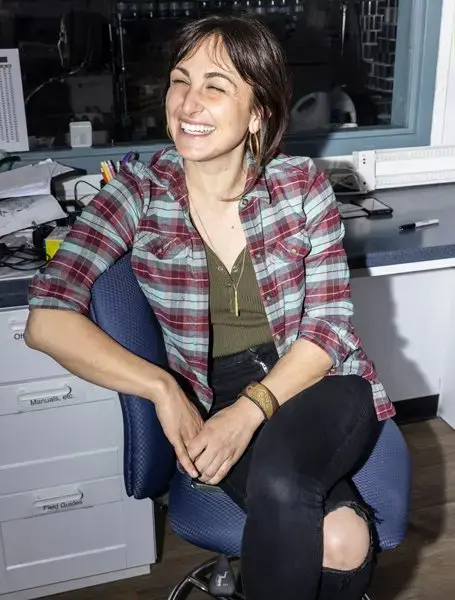
Atlantic Sea Farms CEO Briana Warner. Image by Greta Rybus. United States.
A former diplomat specializing in economic development, Warner knows that her company’s success is built on nitty-gritty details. “The reality is: machines break. Every machine downstairs we had to create from scratch, because it doesn’t even exist in Asia . . . because they’re eating dried kelp,” she explains. “Every safety protocol, we’ve had to come up with.”
Early on in Warner’s tenure as CEO, the company almost went under due to processing issues. In February 2020, a deal ASF had reached to supply Maine-grown kelp to Sweetgreen, in a collaboration with celebrity chef David Chang, evaporated as the pandemic shut down the chain’s business. Back then, ASF had limited storage space and needed somewhere to store 240,000 pounds of kelp pouring in from its farms when the deal fell through. Warner tapped into her network of Maine businesses, and Bristol Seafood, a fish wholesaler based out of Portland, came to the rescue.
“They froze almost every bag of kelp,” says Warner, getting teary. Bristol gave her a bill for $3,000—far less than the true cost of their services—at the end of the season.
The event was clarifying for Warner. She plunged into fundraising for an ASF processing center and worked on consumer marketing. Now, the company has four products in every Whole Foods in the country, foods in national supermarket chains like Sprouts and Albertsons, and 20 ingredient partners like Thorne and Navitas.
For the 2023–2024 season, they harvested a record-breaking amount of kelp: 1.3 million pounds. “You can’t have this incredibly positive impact on the environment, on the food chain, on our partner farmers . . . unless you run a really good business,” Warner says.
ASF’s dedication to infrastructure also pays off for the consumer. When a shopper buys one of the company’s burgers, they can look up where the kelp grew, who harvested it, and when. This is a markedly different situation than with seafood writ large, where one-third of grocery store labels have been found to be wrong.
Traceability is the cornerstone of a larger shift toward the blue economy, a movement among coastal and ocean nations that equally supports workers’ rights, environmental concerns, and sustainability goals. It is a huge selling point for the millions invested in American-grown kelp.
For seaweed growers outside Maine, the logistics still have a long way to go.
Alaska: Dealing With Distance
After Maine, the next biggest kelp-producing state is Alaska. It’s also the most productive state on the West Coast, harvesting 871,000 pounds in the 2022–2023 season. With more than 33,000 miles of shoreline and 41,000 people directly employed in seafood industries in 2022, according to the state’s Department of Labor, as well as access to marine science institutions like the University of Alaska, many here expected seaweed farming to boom when it was first legalized in 2016.
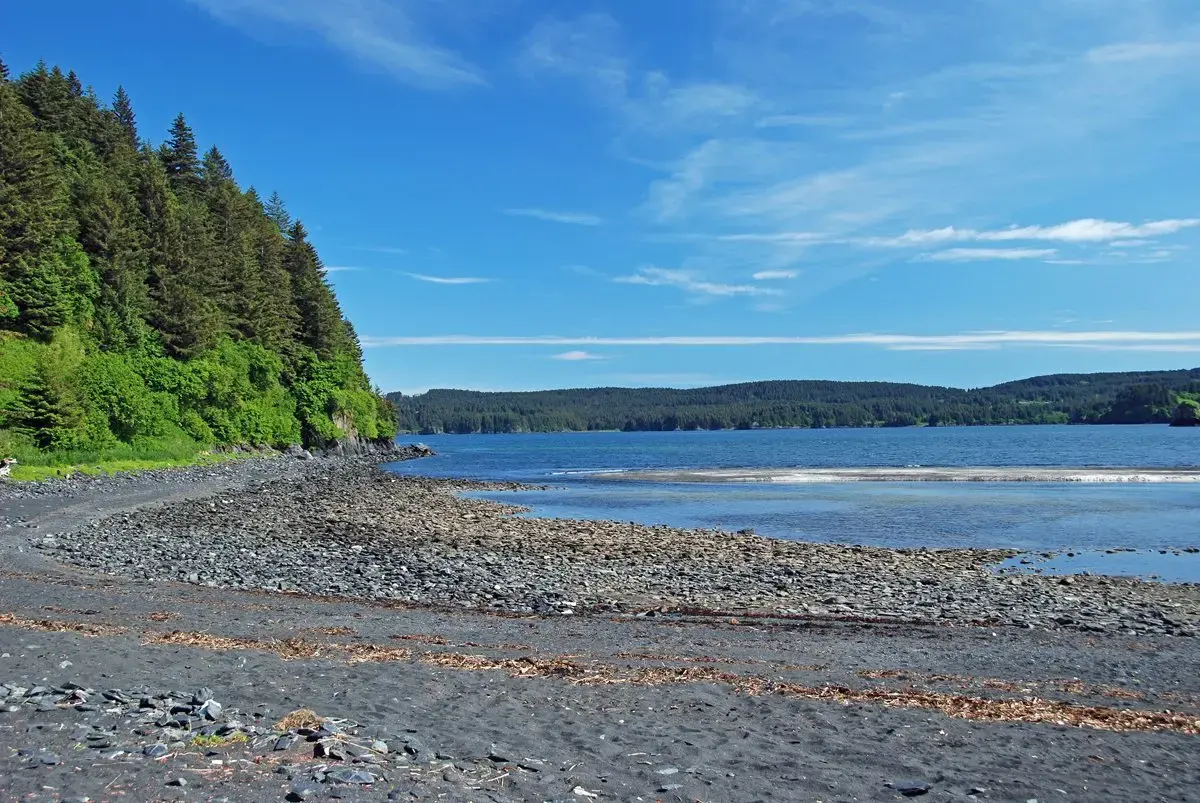
Kodiak Island in the summer. Alaska’s thousands of miles of coastline could help the state develop a booming seaweed-farming industry. Image courtesy of Civil Eats. Unites States.
Federal officials also bet on Alaska’s rapid transition to seaweed farming. In 2022, the U.S. Department of Commerce’s Economic Development Administration (EDA) announced $49 million to jump-start the state’s seaweed and shellfish industry, with a quarter of those funds earmarked for Alaska Native communities.
But for farmers and companies, the kelp boom hasn’t quite happened yet. In 2016, one of the first seaweed companies to open after legalization here went on a hiring spree and immediately started putting buoys into the water. According to former employees, they were expecting to hit 1 million pounds of harvested kelp in a few years. Instead, they’ve significantly reduced operations since then, although they do maintain a farm in Alaska. As for the EDA’s 2022 funding, it is still being allocated, and to an industry that’s just beginning to take shape.
Alaska’s mammoth size presents the biggest hurdle: At 663,268 square miles, it’s much larger than any other state and even most countries. Kelp-producing regions can be thousands of miles away from one another. Many of these coastal communities aren’t connected by road, and the only way to haul kelp from farm to processor is by boat. Even after kelp is made into a final product, it still has to be shipped to Seattle, 2,000 miles south.
“We’ve looked at chartering an Alaska Airlines plane,” says Lia Heifetz, laughing. Heifetz is the co-founder of Barnacle Foods, a vertically integrated kelp company known for its Bullwhip Kelp Hot Sauce. She isn’t kidding; in its early days, her company explored flying thousands of pounds of fresh kelp from Kodiak to its headquarters and processing facility in Juneau, a distance of 500 miles. Heifetz admits that the plan wasn’t cost effective—and came with quite a carbon footprint—so they dropped the idea.
Now in its eighth year of business, Barnacle Foods works only with farms within a 70-mile radius. The company still ships everything by boat, relying on commercial fishing vessels, thanks to relationships with fishers that Heifetz has built over the years. To process their kelp, Barnacle has slowly constructed a 3,000-square-foot production floor and additional warehouse. While Heifetz wouldn’t disclose how much they’ve invested in the facility, she points out that one machine, a “capper” for jars, cost $40,000. Other equipment includes container freezers, container refrigerators, and two forklifts.
“Some level of primary processing or stabilization needs to happen at any port [where] there’s a kelp farm,” she says, adding that a single processing company—and there are only a few others in the state—is unlikely to be able to serve thousands of miles of coastline.
“Most of the profit is coming from having farms double as grant-funded research.”
Farmers and kelp companies say that a cohesive strategy at the state level, particularly around what types of kelp products to initially focus on—food, fertilizer, or bioplastics, for example—could help farmers and kelp companies build infrastructure more efficiently.
As the $49 million in federal EDA funds are being dispersed through the Southeast Conference’s Alaska Mariculture Center, up to $10 million will go toward infrastructure-related projects; other funds include the Native Regenerative fund, aimed at providing money for permitting, equipment and lease fees for Native Alaskans; a Kelp Climate fund operated by GreenWave, a kelp nonprofit; and the Saltonstall-Kennedy Grant, which can help address processing issues.
An additional challenge for Alaska kelp processing is the cost of energy, which varies widely. Each coastal community is isolated, often operating on its own electrical grid and using a variety of energy sources. Juneau has hydropower, which means Barnacle Foods has relatively low electricity costs, according to Heifitz. In other parts of Alaska, diesel generators can be the only source of electricity, a high-cost option that could deter some types of processing, like freezing.
Because of these expensive bottlenecks, farms have to make money in creative ways. “Most of the profit is coming from having farms double as grant-funded research,” says Brianna Murphy. A former commercial fisher, Murphy and her co-founder, Kristin Smith, created Mothers of Millions in 2021 to do just that, funded by a $30,000 grant from the U.S. Department of Agriculture.
Their mobile kelp hatchery, built on a repurposed fishing vessel, means they can navigate straight to farms with spore-laden kelp ready for propagating, instead of waiting for the kelp to come by cargo plane and then working frantically to revive it. Murphy and Smith are kind of a one-stop shop for seaweed farmers: They also offer on-water processing capabilities, shredding harvested kelp directly from the water.
There’s no shortage of interesting and valuable kelp-farming projects in Alaska, including the Native Conservancy’s kelp program, founded to support Indigenous people in starting their own farms (Native Conservancy founder Dune Lankard was recently featured in the PBS docuseries Hope in the Water for his traditional Eyak kelp cakes).
Over the next several years, as the EDA grants begin to bear fruit, Alaska could edge closer to realizing the farming potential of its thousands of miles of coastline.
New York: Starting from Scratch
For other coastal states trying break into this nascent blue economy, commercial processing often doesn’t exist. Most kelp companies are based in Maine or Alaska, so farmers elsewhere must rely on themselves to harvest, process, and create end products.
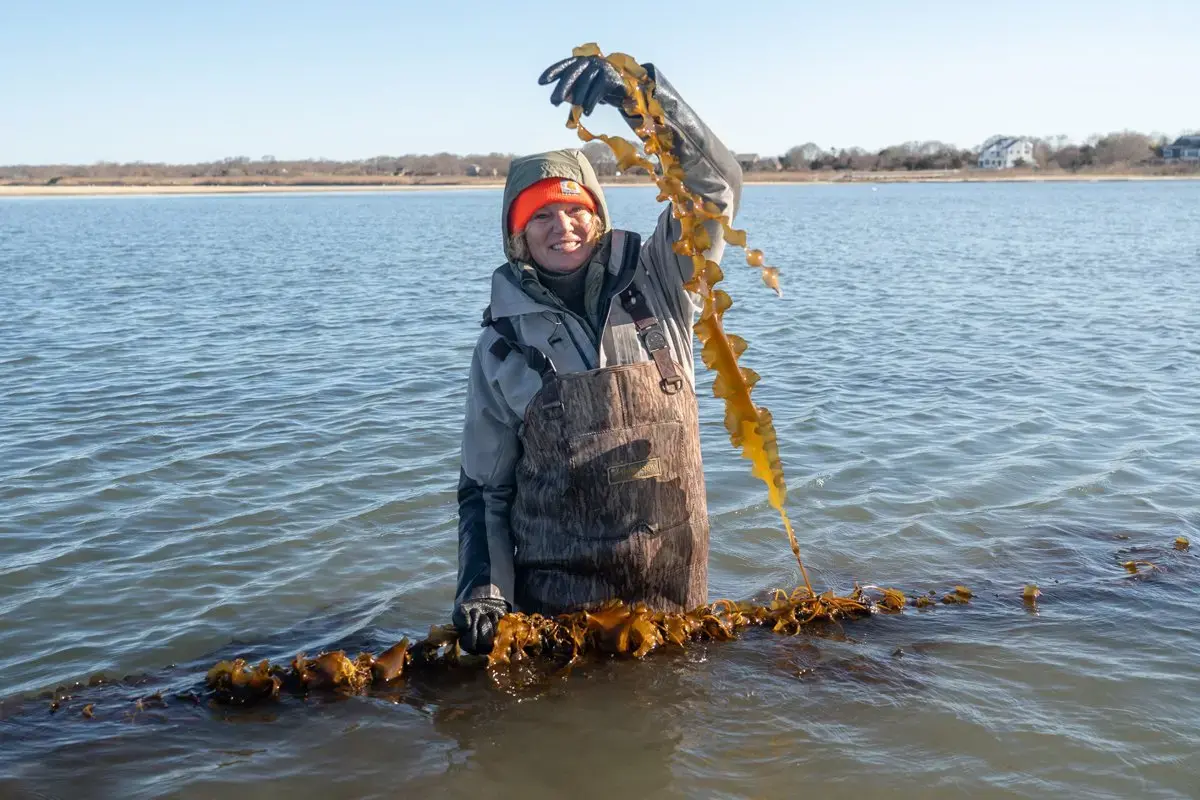
Sue Wicks lifts a line of sugar kelp. Image by Alexandra Talty. United States.
One determined New York oyster grower came up with her own solution.
“This is my bay, a tiny piece of a world that is besieged on every side with climate change and pollution,” says Sue Wicks, the founder of Violet Cove Oysters. Each day, Wicks motors 20 minutes from her house to her 2-acre farm on the Great South Bay, using a Pickerell clamming boat that was designed specifically for this body of water.
“With this little spot, I feel an opportunity, a space to do something tangible,” she says, looking out at her acreage, oyster cages bobbing in the distance as she checks the growth on her kelp lines. She plucks off a furl of young sugar kelp and chews it, enjoying its briny sweetness.
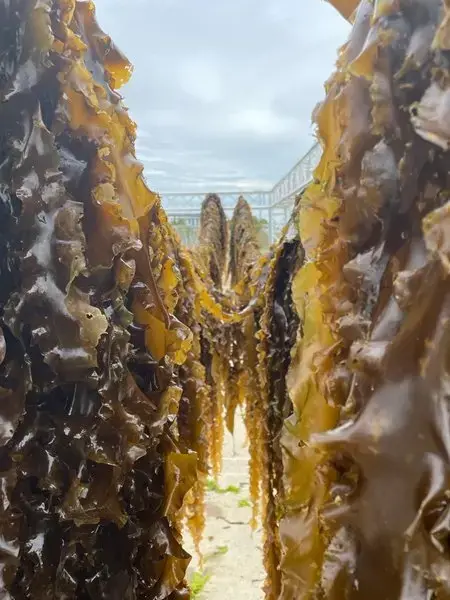
Sue Wicks’ sugar kelp in its initial drying phase. Image courtesy of Sue Wicks. United States.
A former Women’s National Basketball Association star, Wicks became an oyster entrepreneur after retiring from professional sports, inspired to work on the waters that her family has fished for more than 10 generations. Her ancestors could harvest shellfish by hand, but wild stocks have plummeted in Wicks’ lifetime, a consequence of warming waters and nitrogen pollution. After witnessing the decline of her families’ livelihood and pastimes—the traditions of clamming, oystering, fishing and scalloping—she wanted to restore the waters that surrounded her house and hometown. In 2019, she began growing seaweed as part of a research project with Stony Brook University.
After receiving the state’s first commercial kelp farming lease for the 2023–2024 season, Wicks began construction on New York’s first processing center, a dehydrator. Supported by Lazy Point Farms, a New York-based nonprofit, the center cost around $50,000 to build, said Wicks, and is part of a public-private partnership with Suffolk County and the nearby town of Brookhaven. She’s already started using it for this season’s haul.
Wicks first dries her kelp near the water, on racks in the open air, where it shrinks to 20 percent of its original size. Then she moves the racks to a shipping container equipped with a heater exhaust fan and dehumidifier to finish drying completely. Everything is powered by solar, bringing the whole process as close as possible to net-zero emissions.
The shipping container can be converted into a mobile unit, she says, and it’s easily replicated. As for the dried seaweed, Wicks is experimenting with a hot sauce and a seasoning mix, in collaboration with Lazy Point Farms and available through the nonprofit’s website.
“We don’t have working waterfronts on Long Island anymore, and that makes it very difficult,” says Wicks. She hopes her processing center encourages other oyster growers to try kelp farming, since it gives them a way to create their own shelf-stable product, right after harvest. “The fisheries are part of our heritage. It is who we are. Our biggest success is getting other farmers in the water.”
Drive Sales, Engage Customers via Influencers
Harness the power of real customer influencers to drive sales and reduce advertising costs. Our platform ensures influencers who buy and use your products become credible advocates, creating a buzz that significantly impacts your sales numbers.
AI TOOLS
Tech tools powering the best DTC brands
Rebuy: AI-powered personalization for e-commerce (link)
Klaviyo: Email personalization with AI integrations (link)
Smartly.io: Personalize your Ads 100,000x with AI, per geography and customer use case (link)
Range.me: Meet 3 buyers free, and over 50,000+ emerging food buyers (link)
Okendo: Reviews & Loyalty based on paclaging, flavor, ingredients, CX, and more (link)
Fairing: Attribution Surveys to help make sense of customer intent blackholes (link)
Algolia: Personalized Search using AI for e-commerce (link)
Braze: Personalized Customer Profile Databases (CDP) (link)
THAT’S A WRAP
Stay Cute,
Garry & The Farm2Me Team 🌈
P.S if you enjoyed this , forward it to a friend.
If you’re that friend, subscribe here






